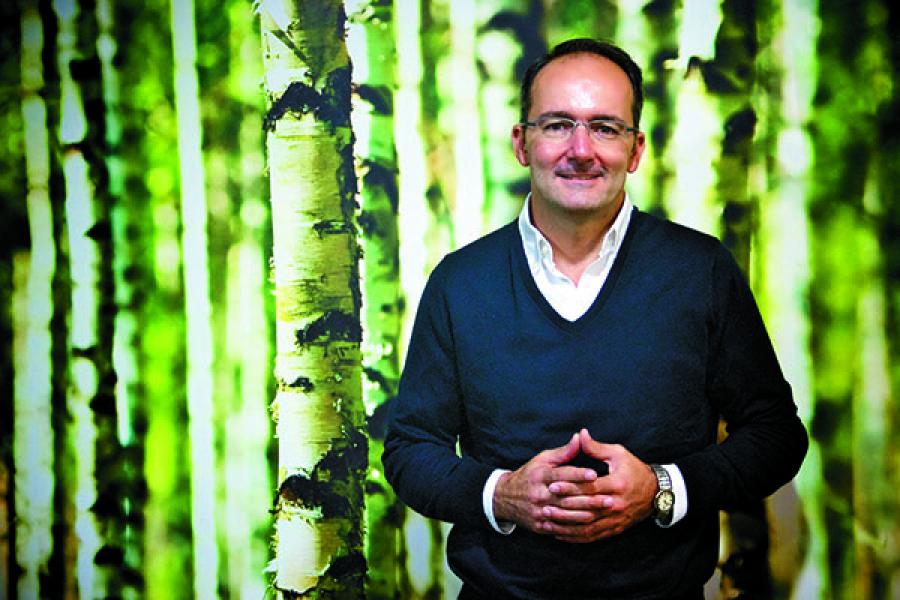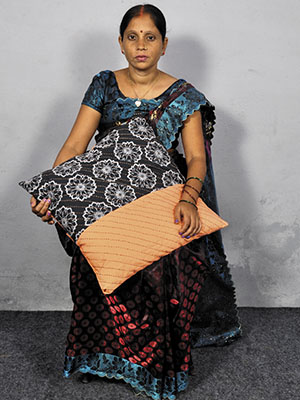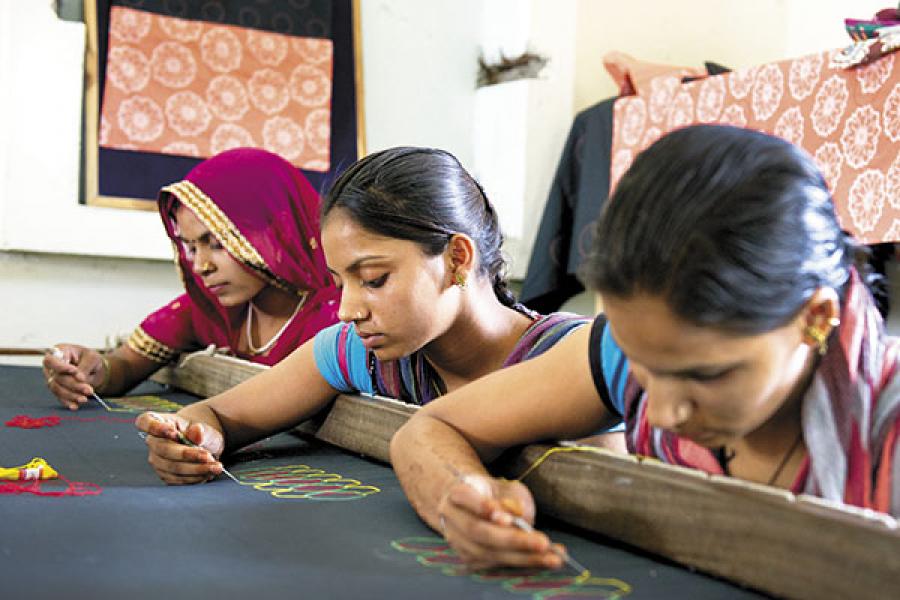
IKEA products: Made in Uttar Pradesh, sold in Sweden
As it gets ready to open its first outlet in India, home furnishing giant IKEA turns to rural and semi-rural regions to help double sourcing from the country from 315 million to 630 million euros
Every day at 8.30 am, Sulekha Bharti steps out of her house in Keshopur Sarpataha in Sant Ravidas Nagar district, Uttar Pradesh (UP), and hails an auto-rickshaw for the half-an-hour, four kilometre drive to the IKEA workshop in Gyanpur, a small town near Varanasi. The day I meet her, she is wearing a bright red sari, her long hair tied neatly in a bun. She is one of hundreds of women in UP who, for the past three years, have been making textile products for the Swedish home furnishing giant.
IKEA, which grossed 28.7 billion euros in sales in FY14, sells ready-to-assemble furniture, appliances, kitchenware and household goods in 46 countries, with its largest markets in Germany, the US and France. Though it doesn’t have a presence in India yet, it has been sourcing products from the country for the past 28 years. In 2014, it procured 315 million euros worth of goods from 48 Indian suppliers; it wants to increase this to 630 million euros by 2020. For now, the goods sourced are mostly textiles, but the Swedish giant is planning to expand the scope and sourcing model, even as it is laying the groundwork for an India store by 2018.
Bharti is part of the retail giant’s most recent initiative—Next Generation—which aims to include and support the development of small-scale entrepreneurs in its supply chain. The handcrafted limited edition products that she makes are shipped to Europe and sold in 31 IKEA outlets across Sweden, Austria, the UK and Switzerland. For the 27-year-old—who, like many of her colleagues in the Gyanpur centre, was married at the age of 15—the novelty of leaving the family house, without the permission of her husband, has yet to wear off. Perhaps it never will. Until three years ago, she was confined within its walls in her role as wife, daughter-in-law, mother (she has two sons aged 5 and 9), cook and all-purpose house help. On the rare occasion when she went outside, she had to cover her face with the traditional ghoonghat or veil.
Then in 2012, after participating in a training workshop, she was recruited by artisan-run social enterprise Rangsutra, which is partnering with IKEA for its Next Generation initiative to produce handcrafted products like cushion covers, pillow cases, table runners, and bedspreads. The Rajasthan-headquartered Rangsutra, which also supplies products to companies such as lifestyle chain Fabindia, is one of IKEA’s 48 suppliers in India. In the south, the Swedish company has partnered with Industree Producer Transform in Bengaluru, which employs around 200 artisans and craftsmen who make shoulder bags, baskets and storage boxes out of natural banana fibre.
Social entrepreneur businesses like these will play an important role in IKEA’s supply chain when it starts shop in India. When the home furnishing company was granted permission to operate in India in 2012, it had announced that it would invest about Rs 10,500 crore over 10 years and open 25 retail outlets across the country. Indian consumers, however, will have to wait for three years before they can shop at an India IKEA store as the company has to build a brick and mortar outlet from scratch.
IKEA recently bought a 13-acre plot in HITEC City in Hyderabad. Though this is the first plot of land it has bought in India, it does not mean that the company will open its first store in the country in Hyderabad. IKEA is simultaneously looking for land in Delhi/NCR, Bengaluru and Mumbai.
The retailer has been struggling to find the right piece of land, especially because a typical store can range from anywhere between 2 and 4 lakh square feet on 8 to 10 acres of land. Its outlets, which can pass off as mini-townships, need to be located near highways with easy accessibility to cities. “We offer about 9,000 home furnishing products for sale. In our stores, we have many room settings that give customers inspiration, a large restaurant and play facilities for children. Therefore, the space required is large,” says IKEA India CEO Juvencio Maeztu, 47.
If all goes as planned, women like Bharti will play an important role in IKEA’s India story, and Next Generation, which IKEA describes as a business initiative with a social mission. The home furnishing company has implemented this initiative with a special focus on countries like Thailand and India that score low on the United Nations sustainable development goals.
Of Veils, Cellphones and Bank Accounts
IKEA takes pride in the change it has brought about among women in the villages of Varanasi. Initially, it was extremely difficult for Bharti to convince her husband and in-laws to let her work. “I faced a lot of taunts from people in my village, including the women. They would ask me if I was working or doing something else [the implications being commercial sex],” she says.
In a happy twist, the women who taunted Bharti three years ago have become her admirers and now work with Rangsutra, which has employed 440 women artisans in UP, in and around two centres (one in Gyanpur and another in Mirzapur) to supply products to IKEA. Rangsutra had delivered about 55,000 pieces to the European company as part of the last order; there are two such orders every year.
The women work from July to September and then from November to February. They can earn as much as Rs 15,000 a month, though most average at about Rs 4,000. (Employees can put in as many hours as they wish into making a product, and have the option of working from home.) The money Bharti makes has earned her respect from her family and the villagers. “My in-laws don’t let me do any housework during the production months. They even send lunch for me at the centre. They have realised that if they free me from the housework, I can earn more money,” she says.
Forbes India visited the Gyanpur centre in June, a non-production month. There are no deadlines to meet, which gives Bharti time to play around with a new embroidery pattern on a cushion cover. She is in a chatty mood constantly exchanging notes with her friends.
She tells me that the ghoonghat that she has worn since her adolescent days is almost a thing of the past. “I wear it at home in front of elders, but here at the centre, I don’t bother with it,” she says. Another employee, 35-year-old Shanti Saroj, chips in, “We encourage each other to avoid wearing the ghoonghat. When we have such beautiful faces why should we hide them?”
Saroj and Bharti are craft managers at Rangsutra with a team of 20 artisans each. As managers, they study and learn new designs before every production cycle and train the artisans under them.
Bharti scored a personal victory a year ago when she convinced her husband to move back to her village from Mumbai. “I was making around Rs 15,000 a month in Mumbai as a tailor but I couldn’t save much,” says her husband Nagendra Kumar. “I missed my family a lot and when I saw my wife make good money, I returned.” Kumar now works with Bharti as a master tailor for IKEA at its Gyanpur centre. (He is one of a handful of men who are part of this project.)
The women have their own mobile phones and operate bank accounts. “Never in my life did I think that I would earn money or deposit money in a bank,” adds Saroj. When she walks into the bank, she still faces taunts, but has learnt to ignore them. It’s a daily battle, but every small victory counts.
Sumita Ghose, founder and managing director of Rangsutra, says the single biggest difference IKEA has made is that it has improved the confidence level among women. “It has facilitated women to come out of their homes and work at the centre, which has improved their confidence and income,” she says. “The latter helps them improve their nutrition and build a better lifestyle [for their families].”
Bharti, for instance, has taken her children out of government schools and enrolled them in English-medium private schools. She also finances the education of her two sisters-in-law, aged 13 and 17. “I want my sisters-in-law to get the best education,” says Bharti, who dropped out of school after she got married.
From a business perspective, limited edition collections help IKEA increase footfalls at its stores. The products made by Rangsutra (and Industree) are clubbed in one collection and shipped to Europe. “These handmade collections are stocked for six to eight weeks in stores, but require six to eight months of production,” says Vaishali Misra, who heads the Next Generation initiative globally. Maeztu adds: “The Next Generation products bring in freshness and newness to our stores, and this attracts visitors. We have seen that when we regularly launch new collections, the customer visits increase, leading to more sales.” He adds that profits made from the Next Generation products are invested into creating new collections, increasing the volume and finding more such social enterprise partners.
Harminder Sahni, founder and managing director of Wazir Advisors, a Delhi-based consultancy firm and a retail expert, says that while the model of tapping local artisans and villagers is not new or unique to IKEA, the difference is in the volume. “While they may not call themselves a socially responsible company, Fabindia has a similar model of involving social enterprises. The difference is that IKEA has a far bigger network. Indian retailers are still very small and they are figuring out how to make money. But in the future, I do see Indian companies involving communities in their businesses,” he says.
IKEA plans to expand its Next Generation initiative to other states once it opens its retail outlets. Its goal is to partner with social enterprises for almost all the services required at a typical IKEA store such as gardening, landscaping, assembling, logistics, cleaning, sewing fabrics, and so on. Food will be a big part of the initiative. “Maximum social enterprises are in the food and agricultural space and that is where intervention is needed,” says Misra.
It’s likely that in India, the company will be sourcing products such as jams and jellies for its India stores from social enterprises. Maeztu says India is the first country where the retailer will work with Next Generation partners in food and other services. “We will collaborate with partners who are located near our stores in order to empower the community through our business,” he says.
Preparing for India
Apart from the Next Generation initiative, IKEA has already started expanding its supplier chain. This is in accordance with India’s foreign direct investment policy for retail, which has a rider, making it mandatory for multi-brand foreign retailers to source 30 percent of the value of goods from small- and medium-sized local suppliers. This year, IKEA has organised three ‘Make more in India’ seminars in Bengaluru, Mumbai and Telangana to look for new suppliers.
While the store launch may still be some time away, IKEA has made it clear that India is a very important market. “We are here for the long term, which for us is not 20 years, but 50 years or even more,” says Maeztu, who works out of the company’s India office in DLF Cyber City, Gurgaon. The furniture retailer sees Asia as a very important market given its continued expansion in the Middle East and Southeast Asia. It has a presence in Jordan, Kuwait, Qatar, Saudi Arabia, Hong Kong, Indonesia, Malaysia, Singapore, Thailand, South Korea, China and Japan. “The market here will grow tremendously in the coming years as more and more people move into the middle class. Our ambition is to be a meaningful brand, and to be affordable and accessible to as many people as possible,” Maeztu adds.
Sourcing, however, has not been easy. “India does not have an organised home furnishing industry except for the textile component,” says Sandeep Sanan, head of sourcing, IKEA India. “We are going to the automotive sector or the white goods sector and trying to inspire them to diversify into making home furnishing products,” he says. That said, it will be adding new categories such as mattresses, sofa covers and work chairs. By 2020, therefore, IKEA plans to double its sourcing from India to 630 million euro worth of products. “Our long-term goal is to have a majority of our supply coming from India,” says Sanan. To be sure, IKEA will have to source products locally to keep the cost of its products low which is what the company is also known for globally.
In terms of the look and feel, the stores will look the same and have the same product range, but the items will cater to Indian sensibilities. For instance, the company has been sending people to volunteers’ homes in cities like Mumbai to find out how they use their furniture. “We are investing a lot in understanding local needs,” says Sanan. “A sofa in an Indian living room is not just a sofa but it is a place where your cousin sleeps, where your daughter does her homework, where a family eats... the challenge for us is how do we create something that meets all these functionalities. Should we make a sofa-cum-bed or should we look at a sofa where we can take off the material for washing.”
The DIY (do-it-yourself) component through which IKEA offers its customers a choice to save money by picking, transporting and assembling the products themselves may not be a big part of its India offering. “In India, we see that the service culture is very widespread and thus we expect customers to demand a large part of the products sold to be home-delivered and assembled by IKEA teams. Our India stores will be built keeping this need in mind,” says Maeztu. IKEA will offer services such as home delivery, assembly and kitchen measurement, design and kitchen installation.
The company has also discovered that its stores will have to stock a range of items that it does not have in the rest of the world such as chapati pans, idli steamers, pressure cookers, stainless steel plates, bowls, glasses and a larger range of spoons. The company has a four-member product development team at its Gurgaon office, which is working on an India-specific range that can be sold to Indians in other countries as well such as the UK, US, Canada and the Middle East, among others.
Sanan is clear that IKEA does not differentiate between the Indian and global market and that any product made locally will be exported. “Even our Next Generation initiative is part of the unique offering we have from India for our global stores,” says Sanan.
Bharti couldn’t be more pleased about IKEA’s decision to market her products abroad. It’s made her a local celebrity as her photograph is printed on the tag of the products in the company’s newest Next Generation collection, ‘KRYDDGLAD’. “Everyone is so proud of it, including my husband,” she says. “My children showed the tag at their school and boasted about how their mother is the face of an international brand.”
(This story appears in the 07 August, 2015 issue of Forbes India. To visit our Archives, click here.)
-
 Ranjan
RanjanDilip kumar singh sir please tell us what are you doing for the poor and helpless peasants of the country please let us know how are you helping country in generatiing jobs and revenue which helps in nation building
on Aug 15, 2015 -
 Dilip Kumar Singh
Dilip Kumar SinghAll these indian and foreign companies are exploiting our poor and helpless peasants. Yes, these companies have provided them a regular job and a little financial security but they give theses workers a pittance as compared to what they charge from their customers. This article just an image building exercise. The author should have also written about the pay these workers get and the retail price of the product made by them.
on Aug 7, 2015-
 Calvin
CalvinIf the pittance feels like goldmine to the peasants, you can imagine their situation. and pessimism doesn\'t work here. The villagers do not have many options; its extremely urgent that private sectors and FDI invests in the talents of rural artisans to give them sustainable employment. Money helps , not just empty words.
on Aug 13, 2015
-

















